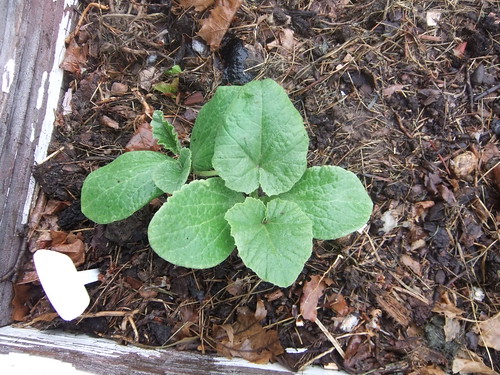Post by keen101 (Biolumo / Andrew B.) on Feb 25, 2016 21:32:05 GMT -5
welcome! Joseph seems to have a definition on his website and his posts that i like. But i have heard others that i agree with.
Funnily enough yesterday i was browsing Alan Kapuler's Peace Seeds website and his Landrace definition was slightly different but acceptable:
as has been pointed out a landrace is probably not the same as a grex. However i suppose i use them interchangeably. That's the great thing about the English language, you can change it on a whim. Perhaps the English language is a grexy landrace.
Perhaps in older times a true farmers landrace would have preceded a grex, which then would eventually become a landrace again. However in modern times it seems so few real landraces exist anymore or are falling out of cultivation, so in modern times a grex seems to preceed a landrace. Call it an artificial landrace or a modern landrace or evolutionary breeding, but it is the same.
check out the wikipedia article on landraces too. I like most of what it says, although it is slightly contradictory in some places. lol.
Funnily enough yesterday i was browsing Alan Kapuler's Peace Seeds website and his Landrace definition was slightly different but acceptable:
If you go into a place where wild, native species still exist you can still find bean species. For thousands of years people have been doing this, putting the seeds in their pockets, bringing them back to their communities and planting them for years to come. When we go to native peoples and obtain some of their bean seeds we call them landraces. They come from species and have been domesticated by growouts, selection, human values and attitudes.
Landraces are cultivated wild species.
When we take cultivated varieties of interbreeding plants like kales, peppers, corns which have been grown and selected for a long time into cultivated lines and remix them by growing, flowering and seeding them together, they intercross. This primary genetic mix has a diverse population of hybrid intercrosses depending on the number and fertility of the initial cultivars.
If one saves the seeds from the mixed intercrosses, plants them again and saves the seeds again, one can continue the process for many cycles. After many years usually one can open up the genome pool and increase genetic diversity. The original parents and all the generations of their progeny, taken together, is also a grex.
In many ways humanity is also a grex.
In terms of vegetables and popular flowers, grexes are intentional. After having grown and selected vegetables and flowers for several hundred years into discrete, recognizable, homozygous lines ie cultivars or cultivated varieties, humanity has begun to remix them.
It seems that landraces precede most grexes. Good grexes require wide crosses and an abundant mixture of parents reflecting genetic diversity in visible and invisible traits. Landraces came from times when there were fewer genetic mixes since the species that gave rise to them were widely distributed.
Right now one can obtain much more genetic diversity than was possible before Columbus, before computers, before being able to easily travel the world and collect seeds and plants. Now we have huge populations of people growing gardens. At the same time we have industrial and corporate monoculture agriculture. Now genetics and molecular biology have changed our understanding of informational macromolecules, inheritance and genomes.
Grexes are a way we solve the issue of how to adapt our foodplants to our local ecosystems and to the exigencies of radical climate change.
Landraces have some aspects in common with grexes. They are not the same thing. They have very different meanings and relationships.
While the term ‘grex’ comes from the latin for ‘flock’ as Margaret Roach so wisely points out and that it was first applied to the lady slipper orchid Paphiopedilum delenatii and its interspecies crosses, a ‘flock’ of birds encompasses the complexity of generation after generation after generation of breeding, all flying in the sky at the same time.
Landraces are cultivated wild species.
When we take cultivated varieties of interbreeding plants like kales, peppers, corns which have been grown and selected for a long time into cultivated lines and remix them by growing, flowering and seeding them together, they intercross. This primary genetic mix has a diverse population of hybrid intercrosses depending on the number and fertility of the initial cultivars.
If one saves the seeds from the mixed intercrosses, plants them again and saves the seeds again, one can continue the process for many cycles. After many years usually one can open up the genome pool and increase genetic diversity. The original parents and all the generations of their progeny, taken together, is also a grex.
In many ways humanity is also a grex.
In terms of vegetables and popular flowers, grexes are intentional. After having grown and selected vegetables and flowers for several hundred years into discrete, recognizable, homozygous lines ie cultivars or cultivated varieties, humanity has begun to remix them.
It seems that landraces precede most grexes. Good grexes require wide crosses and an abundant mixture of parents reflecting genetic diversity in visible and invisible traits. Landraces came from times when there were fewer genetic mixes since the species that gave rise to them were widely distributed.
Right now one can obtain much more genetic diversity than was possible before Columbus, before computers, before being able to easily travel the world and collect seeds and plants. Now we have huge populations of people growing gardens. At the same time we have industrial and corporate monoculture agriculture. Now genetics and molecular biology have changed our understanding of informational macromolecules, inheritance and genomes.
Grexes are a way we solve the issue of how to adapt our foodplants to our local ecosystems and to the exigencies of radical climate change.
Landraces have some aspects in common with grexes. They are not the same thing. They have very different meanings and relationships.
While the term ‘grex’ comes from the latin for ‘flock’ as Margaret Roach so wisely points out and that it was first applied to the lady slipper orchid Paphiopedilum delenatii and its interspecies crosses, a ‘flock’ of birds encompasses the complexity of generation after generation after generation of breeding, all flying in the sky at the same time.
as has been pointed out a landrace is probably not the same as a grex. However i suppose i use them interchangeably. That's the great thing about the English language, you can change it on a whim. Perhaps the English language is a grexy landrace.

Perhaps in older times a true farmers landrace would have preceded a grex, which then would eventually become a landrace again. However in modern times it seems so few real landraces exist anymore or are falling out of cultivation, so in modern times a grex seems to preceed a landrace. Call it an artificial landrace or a modern landrace or evolutionary breeding, but it is the same.
check out the wikipedia article on landraces too. I like most of what it says, although it is slightly contradictory in some places. lol.



